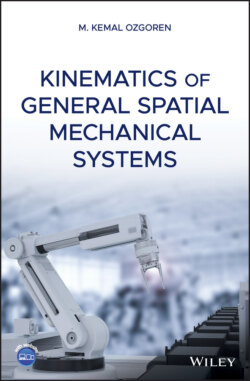Читать книгу Kinematics of General Spatial Mechanical Systems - M. Kemal Ozgoren - Страница 79
3.9.6 Example 3.2
ОглавлениеFigure 3.4 shows the initial and final positions of a cube. The length of each edge of the cube is L = 10 cm. In the first position of the cube, the edge BC coincides with the first axis of the base frame so that OC = 20 cm. In the second position of the cube, the edge GF coincides with the second axis of so that OG = 15 cm. The reference frame that is fixed to the cube is . It is oriented in such a way that , , and .
Figure 3.4 Two positions of a cube.
It is required to express the HTM between the two positions of the cube.
The translation vector can be expressed in as follows:
(3.215)
On the other hand, is oriented with respect to so that
(3.216)
Hence, in , the expression of the translation vector becomes
(3.217)
Then, the column matrix representation of in is obtained as
(3.218)
As for the rotation of the cube, Figure 3.4 implies that
(3.219)
Note that Description (3.219) describes an IFB rotation sequence. Therefore, referring to Section 3.7, the relevant transformation matrices can be obtained as shown below.
(3.220)
(3.221)
(3.222)
Hence,
(3.223)
Having found the rotational and translational displacement matrices, i.e. and , the HTM can then be constructed as follows:
(3.224)
In order to have a detailed expression, the rotational partition can be written as shown below.
(3.225)
Hence,
(3.226)
As a verification of the expression of obtained above, the coordinates of the points A2 and G2 are obtained as follows in :
(3.227)
(3.228)
Note that, by referring to Figure 3.4, both Eqs. (3.227) and (3.228) can be verified by inspection, too. Moreover, Eq. (3.227) matches with Eq. (3.217), as it is supposed to do.
As an additional manipulation with the homogeneous transformation matrices, the coordinates of the points A2 and G2 can also be obtained in as explained below.
The HTM between and can be expressed as follows:
(3.229)
Recall that has already been expressed by Eq. (3.220) as
(3.230)
On the other hand, Figure 3.4 implies that
(3.231)
Hence,
(3.232)
As for the coordinates of A2 and G2 in , they are obtained as follows with the help of Eqs. (3.227) and (3.228):
(3.233)
(3.234)
Note that, by referring to Figure 3.4, both Eqs. (3.233) and (3.234) can again be verified by inspection, too.
